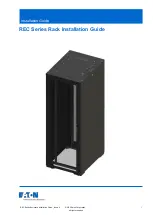
ADCP-96-167 • Issue 5 • July 2016
Page 29
© 2016, CommScope, Inc.
Figure 20. Feeder Cable Fiber Routing to Splice Tray
5. Use lacing or cable ties to secure the feeder cable fiber subunits to the splice tray.
Verify that the feeder cable subunits are the same length as the attached splitter
input fibers. Adjust as needed to make the lengths equal.
6. From the tie point on the splice tray, trim the
feeder cable fiber subunits
to a cut
length of 36 inches (92 cm). Discard excess fiber length.
7. The correct procedure to use for splicing the feeder cable fibers to the splitter
input fibers is dependent on the cable type. If splicing
stranded
cable, refer to
to complete the feeder cable installation. If splicing
ribbon
cable, refer
to complete the feeder cable installation.
5.4
Splicing Stranded Fiber Feeder Cables
The universal splice tray can hold up to 12 stranded fiber splices. Use the following
procedure to splice the stranded feeder cable fibers to the splitter input fibers and to re-
install the feeder splice tray in the cabinet:
1. Starting at the tie-off point on the splice tray, remove the subunit tubes from the
feeder cable fibers to expose the bare individual optical fibers. The bare fibers
should be approximately 36 inches (92 cm) long.
2. Splice the feeder cable fibers to the appropriate splitter input fibers following local
policies and procedures. Refer to
and
identify the splitter input
fiber designations.
Caution: Improper handling can damage fiber optic cables. Do not over tighten cable
ties or lacing as this can cause damage or attenuation. Do not compress the fibers or
allow them to kink.
24367-C
COMMON
TIE POINT
SPLITTER
INPUT
FIBERS
FEEDER
CABLE
FIBERS
CLAMPING
POINT
FEEDER
SPLICE
TRAY
NOTE: SHOWN WITH CABINET AND
SWING FRAME REMOVED TO ALLOW
VIEWING OF FIBER ROUTING
EQUALIZE FIBER
LENGTHS BEFORE
ATTACHING FEEDER
CABLE FIBERS
TO SPLICE TRAY
















































